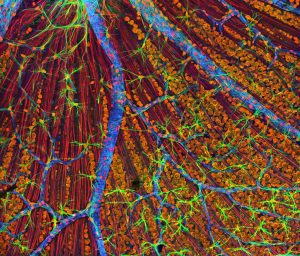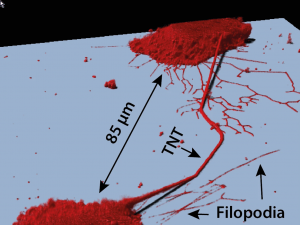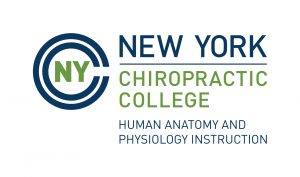Everybody loves to hate teaching with slides. But maybe that's because we've not fully developed our skills! Host Kevin Patton build on previous advice to improve our mastery of the slide-of-hand we need for effective learning. Let's turn that hate into love! This is the first of a two-episode series.
00:00 | Introduction
00:58 | Buy One, Get One
02:06 | I Need Help!
10:20 | Sponsored by AAA
11:47 | Less Text, More Story
24:25 | Sponsored by HAPI
25:49 | Chunky Style Slides
39:44 | Sponsored by HAPS
41:08 | Where Art Thou?
48:16 | Slide Tricks
50:12 | Staying Connected
If you cannot see or activate the audio player, go to: theAPprofessor.org/podcast-episode-95.html
🏅 Apply for your credential (badge/certificate) for listening to this episode: theAPprofessor.org/podcast-episode-95.html/#badge
❓ Please take the anonymous survey: theAPprofessor.org/survey
☝️ Questions & Feedback: 1-833-LION-DEN (1-833-546-6336)
✔️ Follow The A&P Professor on Twitter, Facebook, Blogger, Revue, Tumblr, or Instagram! @theAPprofessor
📰 Get the almost-daily TAPP Science & Education Updates theAPprofessor.org/updates
The purpose of life is not to be happy. It is to be useful, to be honorable, to be compassionate, to have it make some difference that you have lived and lived well. (Ralph Waldo Emerson)
Buy One, Get One
1 minute
This is the first of two episodes in a series about using slides to teach effectively. Yeah, I know—everybody hates the idea of using slides. But maybe it's because we don't know how to use them well. And yeah, some of this has been covered in different ways in previous episodes. But this kind of overlap—or layering—is a proven learning technique, right?
★ Teaching Slides: Smooth and Simple Animations Dramatize the Story of A&P | TAPP 89
★ Slides Serve the Story of Anatomy & Physiology | Episode 66
★ Simple Ideas for Pandemic Teaching | Episode 67
★ The Storytelling Special | Episode 48
I Need Help!
8 minutes
We're all a bit overloaded and overwhelmed these days, right? Yeah, I'm feeling that pain right now. I need help. Will you please help me?
★ TAPP Journal Club with Krista Rompolski
★ Test Question Templates Help Students Learn | TAPP 70
Sponsored by AAA
1.5 minute
A searchable transcript for this episode, as well as the captioned audiogram of this episode, are sponsored by the American Association for Anatomy (AAA) at anatomy.org.
Don't forget—HAPS members get a deep discount on AAA membership!
Less Text, More Story
12.5 minutes
I've said this before. I say it all the time. You're sick of me saying it. But you know what? We need that continual and consistent messaging so that maybe it will eventually become part of our working memory—our conscious awareness. So here, we go again.
★ Teaching Slides: Smooth and Simple Animations Dramatize the Story of A&P | TAPP 89
★ Slides Serve the Story of Anatomy & Physiology | Episode 66
★ Simple Ideas for Pandemic Teaching | Episode 67
★ The Storytelling Special | Episode 48
★ 10 tips on how to make slides that communicate your idea, from TED’s in-house expert (example of a TED Talk) my-ap.us/3gI6FgP
Sponsored by HAPI Online Graduate Program
1.5 minute
The Master of Science in Human Anatomy & Physiology Instruction—the MS-HAPI—is a graduate program for A&P teachers, especially for those who already have a graduate/professional degree. A combination of science courses (enough to qualify you to teach at the college level) and courses in contemporary instructional practice, this program helps you be your best in both on-campus and remote teaching. Kevin Patton is a faculty member in this program at Northeast College of Health Sciences. Check it out!
Chunky Style Slides
14 minutes
If we follow the Universal Design for Learning (UDL) mindset, we know that chunking content into pieces that are easy for students to focus on. But why do we often end up putting a lot of concepts on one teaching slide? Here, I suggest that "chunky style" may be best for learning. And I also suggest that a useful mantra to chant while putting text into our slides is, "think telegraph, not paragraph."
★ Guidelines for Universal Design for Learning (UDL) my-ap.us/UDLguidelines
Sponsored by HAPS
1 minute
The Human Anatomy & Physiology Society (HAPS) is a sponsor of this podcast. You can help appreciate their support by clicking the link below and checking out the many resources and benefits found there. Watch for virtual town hall meetings and upcoming regional meetings!
Where Art Thou?
7 minutes
Lots of ideas on using images effectively in our slides. Images may be the true heart and purpose of using slides to teach.
★ Finding Media | Images and More for Teaching Anatomy & Physiology
Slide Tricks
2 minutes
A wrap up of points made in this episode—there are so many! And a look ahead at the next episode.
If the hyperlinks here are not active, go to TAPPradio.org to find the episode page.
★ More details at the episode page: theAPprofessor.org/podcast-episode-95.html
★ Transcript available in the transcript box: theAPprofessor.org/podcast-episode-95.html
★ Need help accessing resources locked behind a paywall? Check out this advice from Episode 32 to get what you need! https://youtu.be/JU_l76JGwVw?t=440
Take The A&P Professor experience to the next level!
★ theAPprofessor.org/community
Earn cash by referring other A&P faculty to this podcast:
★ theAPprofessor.org/refer
Tools & Resources
★ TAPP Science & Education Updates: theAPprofessor.org/updates
★ Amazon: amzn.to/2r6Qa3J
★ Text Expander: theapprofessor.org/textexpander
★ Rev.com: try.rev.com/Cw2nZ
★ Snagit & Camtasia: techsmith.pxf.io/9MkPW
★ Krisp Free Noise-Cancelling App: theAPprofessor.org/krisp
★ The A&P Professor Logo Items: https://www.teepublic.com/stores/the-a-p-professor
Sponsors
★ Transcript and captions for this episode are supported by the American Association for Anatomy | anatomy.org
★ The Human Anatomy & Physiology Society provides marketing support for this podcast | theAPprofessor.org/haps
★ Distribution of this episode is supported by the Northeast College of Health Sciences online graduate program in Human Anatomy & Physiology Instruction (HAPI) | nycc.edu/hapi
Clicking on sponsor links helps let them know you appreciate their support of this podcast!
Follow The A&P Professor on Twitter, Facebook, Blogger, Revue, Tumblr, or Instagram @theAPprofessor
The A&P Professor® and Lion Den® are registered trademarks of Lion Den Inc. (Kevin Patton)
As an Amazon Associate I earn from qualifying purchases. I may be compensated for links to sponsors and certain other links.
Click here to listen to this episode—or access the detailed notes and transcript.
















